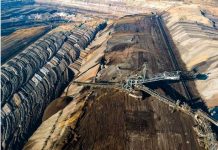Last week, Encana Corp. (TSX-ECA) came out and revealed itself as the huge mystery buyer of Duvernay rights in Alberta, spending $300 million on land acquisition in the first quarter alone.
It’s a big number considering there are only two published drill holes into the Duvernay – and neither one belongs to Encana.
The Duvernay is the hot new play in western Canada – it’s early stage, but Encana’s big purchase shows they believe it will be a highly profitable play – so profitable in fact, the big dog of Canadian gas could become a take-over target itself. The Duvernay is the “source rock” where much of the oil in the Western Canadian Sedimentary Basin was formed – and then migrated upwards into the pools and traps that have been the discovered since the first Leduc well in Alberta in 1947.
The good news for investors is that there is also a swath of intermediate and (cheap) junior gas companies that already have Duvernay rights – these players have had land staked in the area for other formations. Let’s outline some of the stocks that investors could look at for exposure to the latest big shale play in western Canada:
On April 19, Trilogy Energy Corp. (TSX-TET), along with partners Celtic Exploration Ltd. (TSX-CLT) and Yoho Resources Inc. (TSX-YO) announced test results from their second Duvernay joint venture well – 7.5 million cubic feet per day of gas plus – and this is the important part – the well yielded 75 barrels of liquid condensates and 56-degree API oil for every million cubic feet of gas, for some 1,250 barrels of oil equivalent per day.
That condensate is now getting 10% MORE in price than light oil, and has a fast growing local market, as it is used to dilute down the heavy oil from the oilsands to bring it up to pipeline specification so it can flow into the pipeline system.
Ironically, Encana quoted Trilogy’s test numbers as a benchmark of success even though it hasn’t drilled a single horizontal well into the play. In fact, it only has one vertical penetration to date, which it described as “encouraging.” Assuming of course, a company like Encana has enough clout to create “the economies of scale” needed to drive down costs. Indeed, it has shown it has plenty of muscle, even in a weak gas price environment, to do just that.
On a conference call to discuss its disappointing first quarter results, company officials raved that the Duvernay has the potential to be a “top quartile” shale play in North America.
Confidence or cockiness? Given Encana’s reputation as a low cost producer that has become a victim of its own success by unlocking tens of trillions of cubic feet of reserves, we’re going to say both. Let’s face it, they ARE a big part of the reason there’s so much gas around these days.
But what happens next is an investor’s dream. This could be a HUGE new play, like the Horn River in remote northeast B.C., but on a larger scale.
Except Duvernay isn’t northeast B.C. In the Duvernay area, we’re talking about good roads capable of carrying good crews and equipment to work each day. You can even get a good cup of coffee on the way there, and drive back home at night – no camps with extended absences from family. It’s a virtuous circle.
So let’s add this up –
1. the Duvernay has an abundant and highly profitable natural gas liquids, to the point where Encana says it can give the regular dry gas away for free and still make money.
2. There is lots of infrastructure in the area – pipelines, gas processing centres etc.
3. Several junior and intermediate producers already own dozens of sections each of Duvernay rights that haven’t been priced into their stocks yet (this is exactly what happened in the Cardium play in late 2009 and Alberta Bakken plays in mid-late 2010).
So which companies/stocks will likely benefit the most from the emerging Duvernay play?
Companies like Trilogy have been playing Kaybob and another area called Simonette for almost two decades. Almost by accident, it’s now the largest Duvernay land holder after Encana.
Trilogy is either going to become a big fish in a small pond or its going to get swallowed fast. Ditto for Celtic and Yoho, which might as well hang out the for sale sign and get it over with.
Other junior companies that could be ripe for the picking include Donnybrook Energy (DEI-TSXv) and Cequence Energy (CQE-TSX). Both juniors own more than three dozen net sections near where Encana bought a large acreage position for the Duvernay – Donnybrook is on both sides of Encana’s new package – Simonette to the west and BigStone to the east.
Even Encana has been rumored to be a takeover target for a super major like Shell, and its shares must look pretty cheap right at $30 or so, especially if it’s sitting on another Marcellus or Eagleford. Unlike Exxon, Shell has been sitting on the shale gas sidelines and it could be looking to make a move. Taking out Encana would probably be a $40-billion bite and undoubtedly one of the biggest corporate deals in Canadian history (hypothetically speaking, of course).
But it’s not just producers that stand to gain from a big shale discovery in Alberta. Considering this first well cost nearly $18 million to drill and complete, it’s a trickle down economy with all the attendant drilling, completion and transportation stocks having nowhere to go but up.
Even if producers can get the all-in well cost down to $15 million or even $10 million, all your favorite drilling stocks, Precision Drilling Corp. (TSX-PD), Trinidad Drilling (TSX-TDG), and Ensign Energy Services (TSX-TSI), are going to reap the benefits of this next drilling boom.
Along with all your pressure pumpers and frack masters, the Calfracs (TSX-CFW) and Flints (TSX-FES) of the world, whose pumper trucks are the key to making unconventional gas a viable proposition.
And unlike Quebec or New York, even the politicos will get on board this train.
Given that the Alberta government had the scare of its life when its ill-conceived royalty changes just about scared every rig out of the province three years ago, it isn’t eager to make the same mistake twice. The bean counters in Edmonton are probably toasting their good luck about the Duvernay now, because this is the kind of tide that raises all boats, including theirs.
The Duvernay is the gift that keeps on giving. Only now, it’s going to be giving directly to investor’s wallets.
Read Part 1 here: The Duvernay Shale Gas Play








